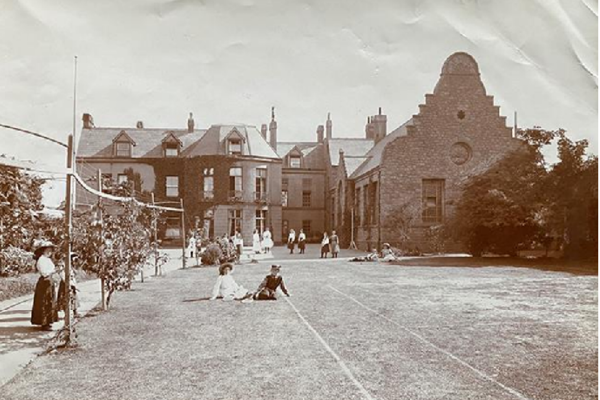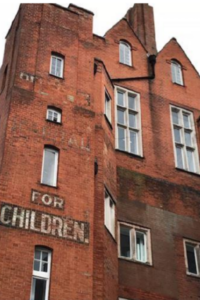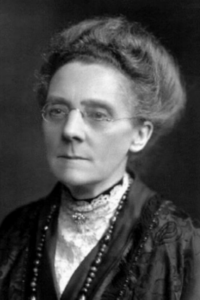This story is one of the runner-up stories in the 20sStreets competition. The competition invited entrants to research and share stories of the 1920s, searching for the most fascinating local history stories covered by the 1921 Census of England and Wales. There were six winning stories and twelve runners-up entries.
Guernsey’s forgotten “Lady Doctor”
By The Ladies’ College, Guernsey – runner-up (one of 3) in the Group category
A century ago, in 1922, an article was published in The Lancet by Dr Sarah Gray, Consulting Surgeon to the Nottingham Hospital for Women, about the management of excessive menstrual bleeding. Dr Gray credited the “inspiring practice” of her hospital colleague, Dr Amelia Le Pelley.[1] Evidence uncovered suggests that Le Pelley should be remembered with considerable
significance in Guernsey, and in the Channel Islands, as the first woman to qualify and practice as a doctor.
Amelia, eight years Sarah’s junior, was a “physician and surgeon” living at 70 Musters Road, Nottingham[2] but she was not a native of the Midlands. “Le Pelley” is a Norman name, notably
found as the Seigneurs of Sark, the tiny Channel Island which for centuries has been a royal fief; the 1891 census shows that 98% of ‘Le Pelleys’ were in the Channel Islands.[3]
Amelia’s paternal grandfather, Ernest, had been Seigneur of Sark [4] an ancient feudal position, though the family had been forced to sell the seigneurie some twenty years before Amelia’s birth.[5] On her mother’s side, the family was established Guernsey society as well. Frances Carey, Amelia’s mother, was the daughter of Sir Peter Stafford Carey who was knighted at Windsor Castle and served as Bailiff of Guernsey.[6]

The Ladies’ College Guernsey, established in 1872, private archive [8]
Island because of the establishment, in 1872, of a school for girls, Ladies’ College [8]. It was founded on the model of Cheltenham Ladies’ College with the first principals hand-picked by the indomitable Dorothea Beale. Dorothea’s sister, Alice, even taught in Guernsey briefly.[9]
By the time Amelia enrolled in the 1880s, the school was thriving, despite suspicion about the merit of female education. One observer commented that the girls’ future husbands would sooner their wives could “make a pudding” than craft an essay.[10] Years after Amelia left, the College principal still had to justify the school’s academic ethos to “fathers” who suggested the “mental strain” might be too much for their daughters[11].Prize lists show Amelia excelled academically, yet Victorian attitudes to women entering the professions were entrenched in much of society. At the 1882 prizegiving, Amelia won a French Prize. The keynote speech by the Principal of Elizabeth College, a long-established boys’ public school made his views clear:
Certainly… I have no great admiration for women doctors, nor do I think they would make good stock-brokers or merchants, or lawyers or members of parliament. There are certain branches of men’s education which may be useless for women, although I cannot see why the mistress of a house should not be better for a little technical knowledge say… natural science seeing that she is responsible for the sanitary condition of her house.[12]

Stained Glass window at The Ladies’ College, Guernsey, private archive. [13]
After completing her schooling, Amelia matriculated at the London School of Medicine for Women, under Elizabeth Garret as Dean.[18] As well as academic endeavour, Ladies’ College had
a reputation for theatrical performance and, though Amelia’s name isn’t among the scant records of participants, perhaps this stuck with her[19]. In 1894, she joined with fellow students to perform Christmas entertainment for patients of the Royal Free Hospital. Amelia’s comic double act with another student, a riff on stereotypes of arts and science students, was the evening’s highlight.[20]

A picture of the Belgrave Hospital for Children, Historic England [24]

Dr Sarah Gray, 1860-191, First woman GP [36]
part of a pioneering generation of female doctors. The BMJ records that in 1904, Amelia was among a few dozen who donated to a fund in the name of Miss EB Pellatt, LSA (Licentiate of the Society of Apothecaries, the qualification that had allowed Elizabeth Garrett to practice in the nineteenth century). [34] This fund was supported also by Flora Murray and Sophia Jex-Blake, the former a suffrage campaigner and physician to Emmeline Pankhurst, and the latter a founder of Amelia’s medical alma mater. Pellatt herself supported the suffragettes, using her credentials to challenge the practice of forcible feeding. [35] By 1905, Amelia was working in Nottingham, and acquainted with Sarah Gray [36]. Both attended a talk about women’s work in a rapidly changing world. The speaker declared that, “They, as women, had woke up to the fact that it was in their power to do a great deal more than it was possible to do 100 years ago.”[37] In 1907, their
friendship no doubt established, the two appeared consecutively in a mourners’ list from the funeral of an elderly doctor [38]. The April 1911 census showed Amelia had one female servant in her household.[39] That same month, Amelia presented Sarah’s paper on dysmenorrhea – painful menstrual cramping – to the Nottingham Medico-Chirurgical Society. [40] The BMJ also noted her
contribution to a discussion about anaesthesia around the same time.[41] That Amelia had involved herself in discourse about anaesthesia may have caused wry amusement; when Sarah was first
employed in 1899, her male colleagues were so doubtful of female ability that they insisted a male doctor be present every time she administered anaesthesia. [42] Though Amelia’s political views are elusive, Sarah was active in the NUWSS43 and it seems wholly plausible Amelia also supported the principle of women’s enfranchisement. The pair lived around two miles apart.[44]
As the 1920s dawned, women’s voting rights partially granted, the two doctors were among a handful of women furthering research into aspects of female health previously given little
attention by the male medical establishment.[45] Amelia was an “exceedingly popular” doctor, serving her community throughout the 1920s.[46] She no doubt came across all manner of medical
problems during her career. A newspaper reported on her attending to the collapse of an elderly woman who subsequently died of a cerebral haemorrhage.[47] Though pre-NHS, Public Health was improving; the Medical Officer for West Bridgford reported in 1925 improvements in housing and sports facilities.[48]
Amelia died in Nottingham in May, 1937 [49]. The Nottingham Journal, said she had been seeing patients, including visiting them at home, until a week before her death [50]. There were few close relatives to tell her story. Her sister Fanny, two years her senior, died in 1900 [51]; her youngest sister, Emily, in 1914 [52]; and, finally, Caroline, who had spent her life in nursing, in 1921 [53]. None of them had married and, though her brother Edward, by then pursuing a military career, was married at the time of the 1911 census, it seems he, too, was childless. [54] Sarah Gray died in 1941.[55]
Unlike some of her contemporaries, Amelia hadn’t kept in contact with her former school. Three years after her death, life on the Island was profoundly disrupted by German Occupation. Her
former school moved premises in the 1960s, its beautiful hall later falling into disuse. Amelia’s significance had been lost to history. But in 2022, through archival research prompted by Ladies’ College’s sesquicentenary, she has been found. Those stained-glass windows, which may have inspired her, are soon to be preserved for the twenty-first century as the site is redeveloped for a use Amelia would no doubt have found pleasing, a medical practice.[56]
Sources:
- https://www.thelancet.com/journals/lancet/article/PIIS0140-6736(01)17046-7/fulltext
- Wright’s Directory of Nottingham, 1913-14 – Historical Directories of England & Wales – Special Collections
- https://www.ancestry.co.uk/name-origin?surname=le%20pelley
- https://ia800209.us.archive.org/30/items/plantagenetrollo01ruvi/plantagenetrollo01ruvi.pdf
- https://www.priaulxlibrary.co.uk/articles/article/cachemailles-descriptive-sketch-island-sark-school-girls
- https://www.findmypast.co.uk/transcript?id=GBOR%2FKNIGHTS%2FREALM%2F005548
- https://www.findmypast.co.uk/transcript?id=BMD%2FB%2F1869%2F2%2FAZ%2F000409%2F031
- The Ladies’ College Guernsey, private archive
- https://ladiescollege.cortes.websds.net/PDFViewer/web/viewer.html?file=%2fFilename.ashx%3ftableName%3dta_publications%26columnName%3dfilename%26recordId%3d8%26page%3d9%26end%3d11%26zoom%3dpage-fit&searchText=beale
- https://www.britishnewspaperarchive.co.uk/viewer/bl/0000184/18720404/034/0002
- https://ladiescollege.cortes.websds.net/PDFViewer/web/viewer.html?file=%2fFilename.ashx%3ftableName%3dta_publications%26columnName%3dfilename%26recordId%3d2%26page%3d5%26end%3d11%26zoom%3dpage-fit&searchText=greek
- https://www.britishnewspaperarchive.co.uk/viewer/bl/0000184/18820727/006/0002
- The Ladies’ College Guernsey, private archive, Note: The window has suffered damage and the image of Mary Somerville is now defaced
- https://www.britishnewspaperarchive.co.uk/viewer/bl/0000184/18800722/012/0002
- https://kingscollections.org/nurses/j-l/le-pelley-caroline-mary-1869
- https://discovery.nationalarchives.gov.uk/details/c/F32043
- https://www.britishnewspaperarchive.co.uk/viewer/bl/0000184/18830726/006/0002
- LONDON SCHOOL OF MEDICINE FOR WOMEN | London Metropolitan Archives (lma.gov.uk)
- https://www.britishnewspaperarchive.co.uk/viewer/BL/0000184/18850219/015/0002?browse=False
- https://www.bmj.com/content/2/1773/1462.3
- https://archives.libraries.london.ac.uk/resources/graduates2ocr.pdf
- https://www.britishnewspaperarchive.co.uk/viewer/BL/0000184/18961003/017/0002?browse=False
- https://pdfslide.tips/documents/appointments-586dca3f0f741.html?page=1
- https://historicengland.org.uk/listing/the-list/list-entry/1358241
- https://www.britishnewspaperarchive.co.uk/viewer/BL/0001580/18990923/053/0005?browse=False
- https://www.britishnewspaperarchive.co.uk/viewer/BL/0000184/19000913/013/0002?browse=False
- https://www.findmypast.co.uk/transcript?id=GBC%2F1901%2F0033849284
- “A Woman’s History of Guernsey” Rose-Marie Crossan, Mor Media, 2018, p.46
- https://www.britishnewspaperarchive.co.uk/viewer/BL/0001580/18990923/053/0005?browse=False
- https://www.theislandwiki.org/index.php/Grandin
- https://www.britishnewspaperarchive.co.uk/viewer/BL/0003131/19050114/038/0002?browse=False
- https://www.findmypast.co.uk/transcript?id=BMD%2FD%2F1901%2F4%2FAZ%2F000225%2F079
- https://brotherscemetery.wordpress.com/tag/le-pelley/
- https://www.bmj.com/content/2/2285/1021.1
- https://www.britishnewspaperarchive.co.uk/viewer/BL/0002187/19091008/016/0003?browse=False
- https://nottinghamwomenshistory.org.uk/wp-content/uploads/2020/12/Dr-Sarah-Gray.pdf
- https://www.britishnewspaperarchive.co.uk/viewer/bl/0000321/19050328/053/0006
- https://www.britishnewspaperarchive.co.uk/viewer/bl/0000321/19070419/030/0005
- https://www.findmypast.co.uk/transcript?id=GBC%2F1911%2FRG14%2F20477%2F0069%2F1
- https://www.bmj.com/content/1/2622/756
- https://www.bmj.com/content/1/2621/687.2
- https://nottinghamwomenshistory.org.uk/wp-content/uploads/2020/12/Dr-Sarah-Gray.pdf
- https://map.mappingwomenssuffrage.org.uk/items/show/253
- https://www.findmypast.co.uk/transcript?id=GBC%2F1911%2FRG14%2F20512%2F0579%2F1
- For example, from “Unwell Women: A Journey Through Medicine and Myth in a Man-Made World”, Elinor Cleghorn, W&N, 2021 p.261, the research of Dr Alice Sanderson Clow is published in 1924.
- https://www.britishnewspaperarchive.co.uk/viewer/BL/0001898/19370501/139/0007?browse=False
- https://www.britishnewspaperarchive.co.uk/viewer/bl/0002861/19300503/151/0008
- https://www.britishnewspaperarchive.co.uk/viewer/BL/0002885/19250321/047/0004?browse=False
- https://www.findmypast.co.uk/transcript?id=BMD%2FD%2F1937%2F2%2FAZ%2F000566%2F064
- https://www.britishnewspaperarchive.co.uk/viewer/BL/0001898/19370501/139/0007?browse=False
- https://www.findmypast.co.uk/transcript?id=BMD%2FD%2F1900%2F1%2FAZ%2F000288%2F199
- https://www.findmypast.co.uk/transcript?id=GBOR%2FGOVPROBATE%2FC%2F1915-1915%2F00040734
- https://www.findmypast.co.uk/transcript?id=BMD%2FD%2F1921%2F3%2FAZ%2F000493%2F036
- https://www.findmypast.co.uk/transcript?id=GBC%2F1911%2FRG14%2F10174%2F0903%2F1
- https://www.britishnewspaperarchive.co.uk/viewer/BL/0001898/19410221/093/0005?browse=False
- https://www.youtube.com/watch?v=6Zz-mlGyafo